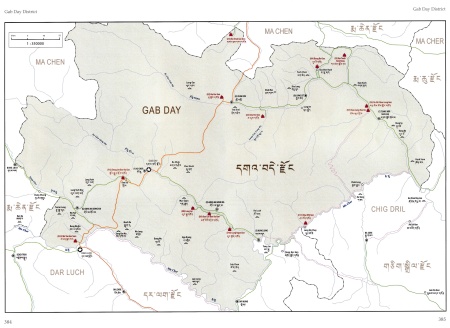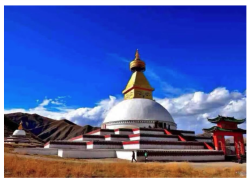Gadé

Gadé (Tib. དགའ་བདེ་, Wyl. dga’ bde), aka Gadé County (Tib. དགའ་བདེ་རྫོང, Wyl. dga’ bde rdzong, Chin. Gāndé Xiàn甘德县) is a county division of Golok. Located in the southeast of Qinghai Province, China, it is bordering Gansu to the east. It is under the administration of Golog Tibetan Autonomous Prefecture. It is an important breeding area for the black-necked crane. [1], [2]
Geography
Position
Gadé district lies to the north of the Ma Chu river (Tib. རྨ་ཆུ་, Wyl. rma chu) in the northern center of the Golok area. The county shares borders with Machen (Tib. རྨ་ཆེན་, Wyl. rma chen) to its north-west, Ma Chu to its north-east (Tib. རྨ་ཆུ་, Wyl. rma chu), Darlak (Tib. དར་ལག་, Wyl. dar lag) to its south-west and Chikdril (Tib. གཅིག་སྒྲིལ་, Wyl. gcig sgril) to its south-east. The county capital Gadé is located at the Ko Chu river (Tib. ཁོ་ཆུ་, Wyl. kho chu).[3]
Rivers

The central river of Gadé is the Kho Chu (Tib. ཁོ་ཆུ་, Wyl. kho chu) in its western part, a tributary of the Machu river (Yellow River) flowing southwards. The Machu also marks the south-western border of the Gadé county. In the eastern part of Gadé, yet another tributary of the Machu has its source. [4]
Mountains
The main mountains of Gadé county are the following:
- Banma Rentuo mountain is well-known for its towering mountains and flocks of stone sheep. It is located in east of Ganglung Township, its main peak is 4896 meters above sea level.
- Guancang Gorge is 3 kilometres away from Banma Rentuo Mountain. The bottom of Guancang Canyon is 3400-3600 meters above sea level, and the canyon is about 4 kilometers long. Due to a good climate, forest areas dominated by Qinghai spruce, Qilian juniper, birch and aspen mark the hillside on its shore, and there is a large number of wild animals inhabiting the grassland and forests.[5]
Climate
Gadé County has an average annual temperature of -2°C and annual precipitation of 550 mm. It is windy all year round, the average wind speed is of 2.2 m/s. There are many days with strong wind, approximately 69 days annually, wind is above level 8, and mostly paroxysmal, especially in winter and spring. In summer and autumn, wind tends to be softer.
Cities
The main cities of Gadé county are the following:
- Chachu Nak (Tib. ཆ་ཆུ་ནག་, Wyl. cha chu nag, Ch. Jiangqian 江千) ca. 3500 inhabitants.[6]
- Kyidri (Tib. ཁྱི་འབྲི་, Wyl. khyi ‘bri, Ch. Khyinzhi 青珍乡) ca. 3000 inhabitants.[7]
- Tsangkor Sholma (Tib. གཙང་སྐོར་ཞོལ་མ་, Wyl. gtsang skor zhol ma, Ch. Xiazangke下藏科) ca. 5130 inhabitants.[8]
- Gadé (Tib. དགའ་བདེ, Wyl. dga’ bde, Ch. Gāndé 柯曲镇), also called Bakchen by the locals, has about 34,800 residents.[9]
- Gongma Gongma (Tib. གོང་མ་གོང་མ་, Wyl. gong ma gong ma, Ch. Shanggongma 上贡麻) has about 2,960 residents and an elevation of 4,185 metres.[10]
- Gongma Mema (Tib. གོང་མ་སྨད་མ་, Wyl. gong ma smad ma, Ch. Zha Gongma 下贡麻) has about 4,080 residents and an elevation of 3,886 metres.[11]
- Ganglung(Tib. གངས་ལུང་, Wyl. gangs lung, Ch. Ganglong 岗龙) has about 3,970 residents and an elevation of 3,834 metres.[12], [13]
Dharma
Dharma Lineages

The main tradition lineages practised in Gadé are related to:
The largest number of Buddhist institutions in Gadé pertains to the Jonang tradition. A very unusual occurrence is the existence of two monasteries that are Nyingma and Geluk at the same time.
Main Dharma Places
- Gardrak Kar Deden Püntsok Ling (Tib. དགར་བྲག་དཀར་བདེ་ལྡན་ཕུན་ཚོགས་གླིང་, Wyl. dgar brag dkar bde ldan phun tshogs gling) is a monastery of the Jonang tradition with 100 monks located in Kyidri township.
- Chayül (Tib. ཆ་ཡུལ་དགོན་ངེས་དོན་བསམ་འགྲུག་གླིང་, Wyl. cha yul dgon nges don bsam ‘grug gling) is a monastery of the tradition Jonang with 100 monks located in Kyidri township.
- Dungri (Tib. དུང་རི་དགོན་བཀྲ་ཤིས་གཡར་འཕེལ་གླིང་, Wyl. dung ri dgon bkra shis g.yar ‘phel gling) is a monastery of the Nyingma tradition with 85 monks located in Kyangche township.
- Tashi Chöling (Tib. བཀྲ་ཤིས་ཆོས་གླིང་, Wyl. bkra shis chos gling) is a monastery of the Jonang tradition with 150 monks located in Tsangkor township. It is is affiliated to Dzamtang Chöde.
- Lungkya (Tib. ལུང་སྐྱ་དགོན་དཔལ་ངེས་དོན་མི་འགྱུར་བདེ་ཆེན་གླིང་, Wyl. lung skya dgon dpal nges don mi ‘gyur bde chen gling) is a monastery of the Jonang tradition with 200 monks located in Gongma Mema township. Affiliated to Dzamtang Tsangpa Gon, the monastery is developing under the guidance of the charismatic bearded figure Tulku Pema Namgyal. Its assembly hall, where electricity is now installed, has images of Dolpopa, Shakyamuni and Taranatha in it sinner sanctum, and interesting Repkong-style murals that reflect this unusual tradition. The Jamkhang, above and to the right, is an active retreat hermitage.
- Trayalung Gon is the largest monastery within the county and is a branch of Lungkya Gonpa, founded by a Jonangpa monk from Serta. The head lama is Tashi Gyatso, currently living in New York (USA).
- Lungnön (Tib. ལུང་སྔོན་དགོན་/ཝལ་ཤུལ་བླ་མའི་ཆོས་སྒར་/ཐུབ་བསྟན་ཆོས་འཁོར་གླིང་, Wyl. lung sngon dgon / wal shul bla ma’i chos sgar / thub bstan chos ‘khor gling) are two monasteries, the first of the Nyingma tradition with 400 monks, the second having 55 Nyingma monks and 50 Geluk nuns, both located in Gongma Mema township. The first bearing the name Walshül, indicates a close relationship to the Nyingma dominated county of Serta that was ruled by the Walshül family. It is the largest Nyingmapa community of Gadé, and was founded in the 19th century as a branch of Dzogchen Monastery. Its large assembly hall, known as Dechen Podrang, contains 4-5 images of Shakyamuni and Padmasambhava, murals depicting the Drupa Kagyé meditational deities, and the protectors of the Nyingmapa tradition. Other buildings of interest here include the Dukar Lhakang and the Dzogchen Lhakang. The highest incarnation, Pema Chenbu, lives in the USA, but visits his home-monastery regularly.
- Dongyü Dokha (Tib. སྡོང་རྒྱུད་རྡོ་ཁ་དགོན་བསྟན་གཉིས་དར་རྒྱས་གླིང་, Wyl. sdong rgyud rdo kha dgon bstan gnyis dar rgyas gling) is a monastery of the Nyingma and Geluk traditions with 130 monks located in Kochu township. The second name of the monastery Tenyi Dargye Ling shows that the two schools are indeed upheld at the same place. There is a large assembly hall, rebuilt among the residential hermitages, and an impressive mani wall.[14], [15]
Main Teachers
- Tashi Gyatso (Tib. བཀྲ་ཤིས་རྒྱ་མཚོ་, Wyl. bkra shis rgya mtsho)
Customs
Tibetans in Gadé County mostly wear the traditional chuba made of sheepskin material. Men’s dresses go down to their knees, while women’s dresses reach to their feet, and are tied at the waist with long belts made from. Both men and women of Gadé have their long hair braided or open. People like to wear knives, waist knives, and bullet bags. [16]
Internal Links
Notes
- ↑ Emeric Yeshe Dorje, The History of the Düdjom Tersar Lineage, Volume 1: “Golok”, forthcoming.
- ↑ https://en.wikipedia.org/wiki/Gadê_County
- ↑ Stewart Smith, The Monasteries of Amdo, Volume 1: East and South Amdo, 2017, Stewart Smith, p. 137& 246-247.
- ↑ Emeric Yeshe Dorje, The History of the Düdjom Tersar Lineage, forthcoming.
- ↑ https://tibetantrekking.com/amdo-destinations-guide/gade-county/
- ↑ https://mapcarta.com/15963924
- ↑ https://mapcarta.com/N3354722852
- ↑ https://mapcarta.com/15925112
- ↑ https://mapcarta.com/N3294739792
- ↑ https://mapcarta.com/14905734
- ↑ https://mapcarta.com/15927160
- ↑ https://mapcarta.com/15955324
- ↑ Stewart Smith, The Monasteries of Amdo, Volume 1: East and South Amdo, 2017, Stewart Smith, p.288-289.
- ↑ Stewart Smith, The Monasteries of Amdo, Volume 1: East and South Amdo, 2017, Stewart Smith, p.158.
- ↑ Gyurmé Dorjé, Tibet, Footprint, 3rd edition, p.645.
- ↑ https://tibetantrekking.com/amdo-destinations-guide/gade-county/